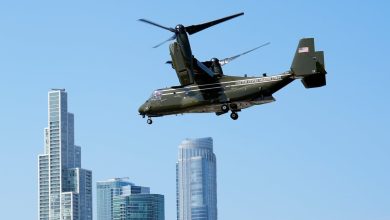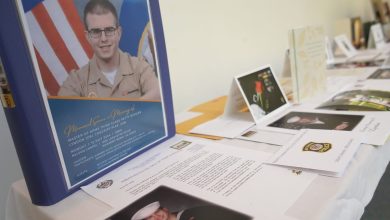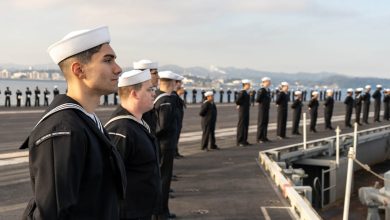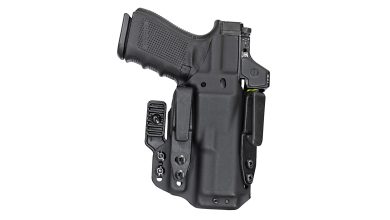The Tactical Games: Six Years Of Evolution

Photos by Mathew Hennessy
The Tactical Games was born in 2018 from the brain of Tim Burke, a career Special Forces soldier. The premise then remains the same as today: merge CrossFit-style exercises with a 2-gun event (rifle and pistol) for purposes of testing one’s accuracy under the stress of both physical exhaustion and competition.
Yet despite a faithfulness to the initial concept, a lot has changed over the past several years. With competitions growing annually, as much as 100 percent or more in terms of participant numbers, new faces with varied levels of skills, combined with being able to host events at sites with more square footage, created the opportunity to offer greater challenges.
Nathan Drumm, 43, served in the Marines for several years, got out of active duty in 2005, out of the reserves in 2010, and now works as a full-time firefighter in Louisiana. Drumm started competing in The Tactical Games in 2019 at Reveille Peak Ranch in Texas, which was the organization’s third-ever match.
Drumm also competes in PRS, sniper matches, other 2-gun events, but prefers The Tactical Games. He has made it to the podium 10 times in the Elite division (the most-difficult division), including a Fourth-place finish at the 2020 national championship and then Fifth at the 2022 championship.
“In the very beginning, the shooting was very rudimentary,” said Drumm. “But it was being programmed by somebody who created the sport and not necessarily a match director.”
A lot of that changed starting in 2021. Jared Halbert, CrossFit athlete and competition shooter with two Tactical Games Men’s Elite National Championships in 2020 and 2021, transitioned from top-podium finisher to CEO and owner.
“He’s a competitive shooter, and he brought a lot of his knowledge, and he brought people who were known good match directors in like the 3-gun world, and multi-gun shooting disciplines,” said Drumm. “They started creating better matches, better shooting.
“That’s when you saw the huge page turn into the tactical games for the better is when he took over,” said Drumm. “The shooting was more interesting. The physical stages were a lot better planned out. Even today, they’re still trying to make it as interesting as possible.”
I competed in my first Tactical Games this past July in Seasboro, Iowa. The best way I can describe it? “A great learning experience.” Here are my key takeaways and what you should you know, should you consider competing.
TODAY’S TACTICAL GAMES MISSION
Nick Thayer is a fitness and competitive-shooting enthusiast, veteran, and business owner. “I started out as a competitor in The Tactical Games, and it quickly became a major part of my life,” Thayer said. “I thoroughly enjoy all aspects of the sport and the work people are putting in to be competitive in it. It is awesome watching competitors from all backgrounds come out and push themselves to be better.”

Thayer now runs the show and plays a role in all stages of planning. “The Tactical Games started as an idea, it formed into a competition, and it became a sport,” Thayer said. “The purpose of this sport is to get people interested in shooting, but also to get people who are interested in shooting interested in fitness, and I think the most important thing that we can have is a healthy interest in firearms in America.
“So our goal is always to get more people that are interested in fitness interested in shooting, and get people that are interested in shooting interested in fitness. I believe The Tactical Games can play a role in the normalization of firearm ownership and can help curve the health epidemic we have in this country. My goal is to see as many Americans as possible interested in shooting sports and physical fitness, not only for themselves but for their families.”
CONSIDERING COMPETING? HERE’S HOW TO GET STARTED
Don’t wait.
“I’ve had a bunch of people reach out to me and say, ‘Oh, I’m not ready,’” Drumm said. “I said, ‘Dude, you’re ready.’ As long as you’re safe with your firearms, just come out and go.”
Drumm had one friend who put if off for two years. Finally, his friend decided to compete. “When he came out, he said, ‘I never should put this off. Like I could have been doing this for two years’. And I said, ‘you’re right.’”
Volunteer first.
Volunteering is the perfect way to experience all the event has to offer while also earning yourself an entry credit. So not only do you learn, but you save yourself the cost of competing.
“When you volunteer, you learn so much,” Drumm said. “Like I volunteered quite a bit and every time I go, I learn something every time. You literally have a sample size of everyone that’s there. And once you volunteer, it kind of takes the mysteriousness of it away. You’re like, ‘Oh, OK, I can do this.’”
Make friends.
Whether through meeting people when volunteering or joining the Tactical Games Training Group, you will find a friendly and encouraging community. There is always someone ready and happy to answer questions and provide advice. These people want to see the sport grow, so most serve as great ambassadors for making that happen.
TIMELINE FOR TRAINING
Start early, as much as six months out, depending on your current level of fitness. There are several sources advising what your level of fitness should be for your division. For example, the Tactical Games suggested I, for my 40-plus Mens Master Division, should be able to run a 10-minute mile with a slick plate carrier (plates included). But I learned after the event: Double or triple whatever they recommend. What that means: Be able to run three miles with a carrier at a 10-minute pace.
A 1.5-mile run may seem easy when fresh but consider a run like that — or longer — could happen Sunday midday as your final event after an exhausting weekend in nearly 100-degree heat and include steep inclines.

If adhering to a six-month training routine, you may wish to focus solely on the physical for the first two months to get your resting heart rate down, which leads to better VO2 levels and an increase of oxygen in your blood content.
For the next two months, incorporate dry-fire into your exercise. Both my buddy and I made good use of Mantis (both for pistol and their BlackbeardX for rifle) and found their gear to be immensely helpful, especially when comparing our heart rates to accuracy. It helped us see how deep breaths and controlled breathing would benefit us when pulling triggers.
For the final two months, if you can afford the ammo and range time, get out and practice via live fire as much as possible in awkward positions. That means shooting offhand, from odd angles on a barricade, outward to as much as 700 yards for rifle, 40 yards for pistol. Take notes and know your data. Try different ammo offerings if necessary to determine what your barrel likes most.
NUTRITION, HYDRATION
Lean protein, colorful vegetables, and starches should be the mantra during training. Ahead of intense workouts and/or runs, as well as the event itself, pack in the carbs via pasta or pizza.
Stay hydrated daily and incorporate a packet of electrolytes. I take one LMNT zero-sugar 0.12-ounce packet daily (as a friend pointed out it’s best to reduce intake of artificial sugars), then, during the event, I alternated between two bottles of water and one with LMNT. Avoid caffeine, especially during the event. Thayer pointed out most any medical emergency involved someone being over-caffeinated.

“These stages will get your heart rate high enough,” he told us at the safety briefing. “No need to supplement with that pre-workout stuff.” And he was right, as my heart rate hit 204 bpm at the end of Sunday’s run.
GEAR CHOICES
How Gucci you want to get, and how much you want to “game it” is all up to you. Below was my loadout complete with insights:
Rifle: Suppressed 12.5-inch AR Pistol
Insights: While mostly consisting of Aero Precision parts, but with a BCM Mil-spec trigger, Radian Weapons BCG, charging handle, and ambidextrous safety, and Vortex’s 1-6×24 Razor HD Gen II and Troy’s angle offset irons, I also ran SilencerCo’s Velos 5.56 suppressor. The gun was complimented for being the quietest in attendance, but in addition to low velocity and bullets meeting dirt and not steel at 450 yards, after enough rounds the 1:7-twist CMV barrel was throwing rounds using Barnes Precision Match 77-grain.

Upon returning home, I visited an indoor range and found when cold, the gun was shooting easily sub-MOA until the fifth round. Then, at over 35 rounds, the groups really opened up. So while I had read “choose a light gun because you’ll have to carry it during workouts,” this was not the case, as the rifle was almost always staged on the ground during stages.
I would have benefited from a longer barrel, likely a birdcage versus a can, and I should’ve done more testing in regard to how a 69- or 62-grain bullet would perform in my barrel when hot.
Pistol: Glock 47
Insights: I installed the Radian Weapons Afterburner and Ramjet compensator and match-grade barrel as well as their guide rode and 18-pound spring. Otherwise, the gun, including the trigger, was stock. On the slide, I ran Vortex’ Defender ST 3-MOA dot, a micro red I really appreciate both in terms of performance and the perfectly sized window.

While most competitors, especially top contenders, run a hammer-fired pistol — Drumm runs a Hayes Custom Cobra — I wanted to compete with a loadout I’d use in a personal defense situation. Since I always carry a Glock, I competed with a Glock.
Plate carrier: Spartan Armor Systems Plate Carrier with Hercules Level IV ceramic plates
Insights: While slick (no mag pouches or attachments), this weighed a little above 15 pounds (the minimum for men). It was comfortable in most scenarios except putting heaving objects on my back, which pushed my back plates down and my front plates up into my throat at times.
So while other competitors ran vests filled with sand and designed for these sort of CrossFit-style workouts, my hard armor was a handicap, but that is what I wanted. Same logic as for using a Glock with a stock trigger, I wanted to practice like I’d play.
Belt: Blue Force Gear CHLK
Insights: I’ve been using this belt for almost two years in competitions. The combo of inner and outer belts works well, and it stays secure and tight on my waist while I have ample MOLLE space for med kits and mag pouches. I also brought their Ten-Speed chest rig in case I needed to quickly bring four magazines to a stage and didn’t want to swap out pouches on my plate carrier.

KEY TAKEAWAYS AND TIPS
Take a look at what you think you need to do, and — bare minimum — double it. Progressively make preparation more uncomfortable — run farther and faster, lift more, shoot from barricades at awkward positions and angles.
Keep track of your progress in every respect. That includes your diet and hydration levels in relation to workout performance, but also your bullet data from 50 to 750 yards. Know bullet rise and drop and bring a rangefinder to the event. Stage designers will assume you guesstimate a target to be 150, but it could easily be 172 and when your target is a small, inverted triangle, having that bullet data and knowing the exact range will matter.
Get faster with your workouts, slower on the gun. When I tried to go too fast on my first plate rack shooting my pistol, my accuracy suffered. “Learn to be slow in a hurry,” as my friend and LE instructor Mike Yoder always likes to say.
In some stages, the ability to finish the workout quicker may mean the difference in an extra round of shooting and thus more points potential.

Be intentional about ammo or bullet choice. “Right now, my wife and I are using Sierra 77s,” Drumm said. “We have also used 69-grain MatchKings for I think two and a half years. Just right now, the barrels we’re using like the 77 just a little bit more.”
Drumm custom loads for longer ranges and marks his magazines accordingly. He knows what bullet works well with what powder (IMR 8208 or StaBALL Match) in what barrel at what range, because he’s put in the time and tuned his setup.
OTHER TIPS
Bring both 30-round and 10-round rifle magazines. When shooting from a rooftop barricade, not having to balance a 30-round magazine makes a big difference.
Be able to mark your magazines with a paint pen. During one stage that called for alternating between 10 and five rounds, I shot five rounds during a 10-round sequence, costing me points.
Use plugs not muffs and preferably the noise-cancelling kind with external mics.
I ran OTTO’s NoizeBarrier Micro plugs, and these made a major difference, as they both lowered loud noises to acceptable and decibels and still allowed for me to clearly hear my spotter or RSO when needed.
Find ways to make yourself as comfortable as possible between stages. This could mean a change or two of clothes should you sweat through other clothes (socks and underwear are biggest considerations here). Bring a chair, at the very least. And have cooler with plenty of water.

Take time to move between stages and after the first day. Lactic acid builds up in your muscles. Get it out via mild exercising or even muscle massages (muscle-massage gun too?) You don’t want your limbs feeling like dead weights on the second day.
A final takeaway came from Drumm: “Don’t worry about buying a lot of expensive gear. As long as you have a pistol — a 9mm, 40, or 45 — and a rifle, use that. Make sure you have a belt. Make sure you have some pouches and don’t worry about buying the most expensive stuff out there. It’s more important that you just try it, right?”
Truth.
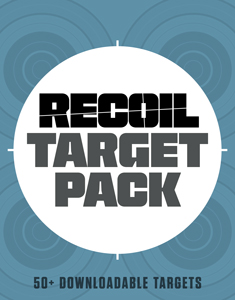
NEXT STEP: Download Your Free Target Pack from RECOIL
For years, RECOIL magazine has treated its readers to a full-size (sometimes full color!) shooting target tucked into each big issue. Now we’ve compiled over 50 of our most popular targets into this one digital PDF download. From handgun drills to AR-15 practice, these 50+ targets have you covered. Print off as many as you like (ammo not included).
Get your pack of 50 Print-at-Home targets when you subscribe to the RECOIL email newsletter. We’ll send you weekly updates on guns, gear, industry news, and special offers from leading manufacturers – your guide to the firearms lifestyle.
You want this. Trust Us.
Read the full article here


